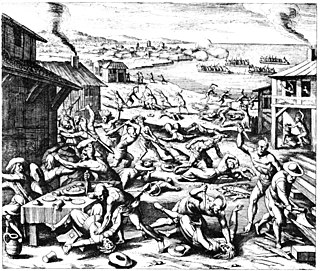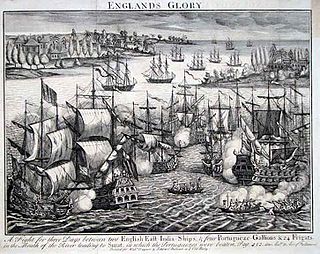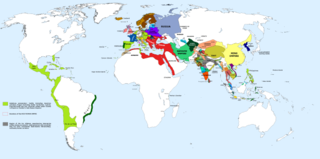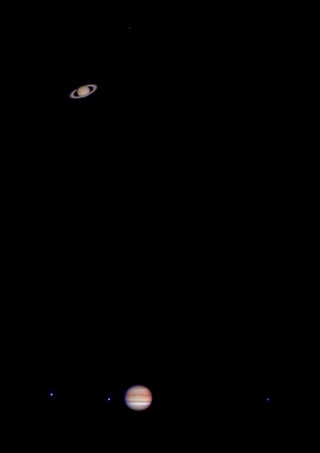Related Research Articles

1623 (MDCXXIII) was a common year starting on Sunday of the Gregorian calendar and a common year starting on Wednesday of the Julian calendar, the 1623rd year of the Common Era (CE) and Anno Domini (AD) designations, the 623rd year of the 2nd millennium, the 23rd year of the 17th century, and the 4th year of the 1620s decade. As of the start of 1623, the Gregorian calendar was 10 days ahead of the Julian calendar, which remained in localized use until 1923.

1707 (MDCCVII) was a common year starting on Saturday of the Gregorian calendar and a common year starting on Wednesday of the Julian calendar, the 1707th year of the Common Era (CE) and Anno Domini (AD) designations, the 707th year of the 2nd millennium, the 7th year of the 18th century, and the 8th year of the 1700s decade. As of the start of 1707, the Gregorian calendar was 11 days ahead of the Julian calendar, which remained in localized use until 1923.

1640 (MDCXL) was a leap year starting on Sunday of the Gregorian calendar and a leap year starting on Wednesday of the Julian calendar, the 1640th year of the Common Era (CE) and Anno Domini (AD) designations, the 640th year of the 2nd millennium, the 40th year of the 17th century, and the 1st year of the 1640s decade. As of the start of 1640, the Gregorian calendar was 10 days ahead of the Julian calendar, which remained in localized use until 1923.

The 1620s decade ran from January 1, 1620, to December 31, 1629.

1612 (MDCXII) was a leap year starting on Sunday of the Gregorian calendar and a leap year starting on Wednesday of the Julian calendar, the 1612th year of the Common Era (CE) and Anno Domini (AD) designations, the 612th year of the 2nd millennium, the 12th year of the 17th century, and the 3rd year of the 1610s decade. As of the start of 1612, the Gregorian calendar was 10 days ahead of the Julian calendar, which remained in localized use until 1923.

The 1550s decade ran from January 1, 1550, to December 31, 1559.

1689 (MDCLXXXIX) was a common year starting on Saturday of the Gregorian calendar and a common year starting on Tuesday of the Julian calendar, the 1689th year of the Common Era (CE) and Anno Domini (AD) designations, the 689th year of the 2nd millennium, the 89th year of the 17th century, and the 10th and last year of the 1680s decade. As of the start of 1689, the Gregorian calendar was 10 days ahead of the Julian calendar, which remained in localized use until 1923.

1673 (MDCLXXIII) was a common year starting on Sunday of the Gregorian calendar and a common year starting on Wednesday of the Julian calendar, the 1673rd year of the Common Era (CE) and Anno Domini (AD) designations, the 673rd year of the 2nd millennium, the 73rd year of the 17th century, and the 4th year of the 1670s decade. As of the start of 1673, the Gregorian calendar was 10 days ahead of the Julian calendar, which remained in localized use until 1923.

In astronomy, a conjunction occurs when two astronomical objects or spacecraft have either the same right ascension or the same ecliptic longitude, usually as observed from Earth.
The year 1899 in science involved some significant events, listed below.
The year 1808 in science and technology involved some significant events, listed below.
The year 2000 in science and technology involved some significant events.
The year 1831 in science and technology involved some significant events, listed below.
The year 1757 in science and technology involved some significant events.
The year 1673 in science and technology involved some significant events.
The year 1622 in science and technology involved some significant events.
The year 1612 in science and technology involved some significant events.

A great conjunction is a conjunction of the planets Jupiter and Saturn, when the two planets appear closest together in the sky. Great conjunctions occur approximately every 20 years when Jupiter "overtakes" Saturn in its orbit. They are named "great" for being by far the rarest of the conjunctions between naked-eye planets.

The Cavendishfamily is a British noble family, of Anglo-Norman origins. They rose to their highest prominence as Duke of Devonshire and Duke of Newcastle.
Events from the 1620s in England. This decade sees a change of monarch.
References
- ↑ Hunt, Jeffrey L. (2020-02-20). "1623: The Great Conjunction of Jupiter and Saturn". When the Curves Line Up. Retrieved 2020-12-05.
- ↑ Ferrand, Jacques. Maladie d'amour, ou Mélancolie érotique.
- ↑ "Margaret Cavendish". The British Library. Retrieved 26 March 2019.